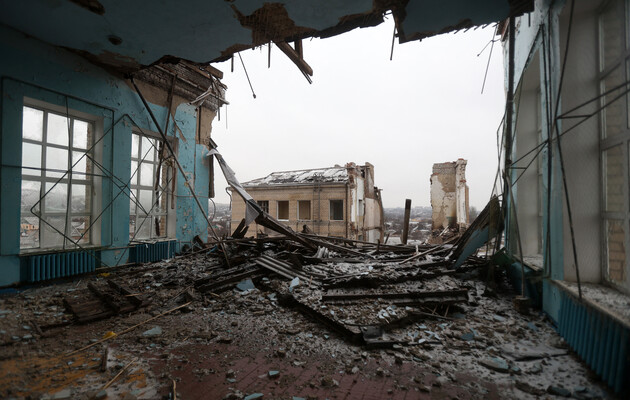Little money and many needs. How to prioritise Ukraine's recovery?

Ukraine's needs for reconstruction and recovery are immense. It is impossible to meet them all at once. Therefore, there is an urgent need to identify key sectors and set clear regional prioritisation annually. How can this be done best, and where to start? Hugues Mingarelli, Head of the EU Delegation to Ukraine (2016-2019) and Director of the European Agency for Reconstruction in Kosovo, Serbia, Montenegro and the former Yugoslav Republic of Macedonia (2000-2002), who took part in the October monitoring of Ukraine's recovery, shared his experience in reconstruction.
In the first two-three years, it is reasonable to focus recovery efforts on Sumy, Kharkiv, Luhansk, Donetsk, Zaporizhzhia and Kherson oblasts, as the east of Ukraine has suffered the most severe destruction of social and economic infrastructure. The majority of reforms should be concentrated in these regions.
Certainly, there will be no country and no economy without people. Thus, the goal of recovery should be to provide incentives for the 15 million people who have fled their homes (8 million refugees in the EU and 7 million internally displaced people in Ukraine) to return home. Several measures must be taken immediately, not in one or two years.
The first priority should be to clear mines and unexploded ordnance, as it is estimated that about a third of Ukraine's territory is mined. It will be a disaster if we don't do this. I experienced this 20 years ago in Kosovo, where we started rebuilding certain infrastructure without paying enough attention to mines. In your country, the situation is much worse than in the Balkans. Therefore, we should never forget this before we return people to the eastern territories of Ukraine.
The second priority is related to ecocide - the terrible environmental disaster that the Russians committed in Ukraine. It is vital to purify the soil and air as soon as possible. To understand the depth of the problem, I will give several examples: since 2014, the Russians have destroyed a lot of chemical and steel plants between Kharkiv and Berdiansk - I witnessed it with my own eyes. Now, the environment contains chemicals that can cause asbestosis. If you want people to return to these areas, you must address this environmental damage immediately.
Another example of an environmental disaster is the regions with coal and iron ore mines between Luhansk and Donetsk. Even when the mines are no longer operating, water must be pumped out of them regularly. Otherwise, contaminated water will infiltrate the groundwater, depriving the areas of drinking water. Since 2014, water has not been pumped out of mines in most of the eastern territories of Ukraine. This problem will have to be resolved if people are to live there.
The third priority in Ukraine should be the population's rehabilitation. For ten years, people in certain regions have been and continue to live under Russian bombardments and missiles. These people need psychological and social support as soon as possible. It is important to remember that the reconstruction and recovery of the country is not just about physical rebuilding. There are millions of people in Ukraine who need to rebuild their lives. Therefore, we need to focus on people who have been traumatised, especially in the areas that suffered from the Russian occupation.
Simultaneously, efforts should be made to meet immediate needs and establish basic infrastructure - water, electricity, heating, medical facilities and schools - that will allow people to return. This should be the main objective of the recovery in the first three years. A bit later on, we need to offer people jobs, and for this, we should create an attractive business environment to encourage domestic and foreign investors to return to the east of the country.
Hence, it is necessary to resume the process of modernising Ukraine. I have seen the fantastic things Ukrainians have been doing between 2014 and 2022 with their political and economic reforms. We must support you to resume the modernisation process as soon as possible. I hope that you will start the EU accession very soon. Remember that you have an obligation to align your legislation with the EU (according to the “acquis communautaire”).
Thus, the entire reconstruction process must be completely transparent and accessible to civil society, local authorities, businesses, and the donor community at any time. That is why a monitoring and evaluation mechanism should be implemented to make the process accountable and ensure sound financial management.
Anyone who knows Ukraine acknowledges the outstanding role of an active civil society. Consequently, it needs to be involved in the annual selection of priority sectors and regions where we should focus our reconstruction efforts, as well as in monitoring the progress of reconstruction projects.
Ukraine has the necessary digital tools, such as ProZorro and the DREAM system. Also in the final stage of launch is the Big Recovery Portal (BRP), a platform being developed by Ukrainian civil society with EU funding. BRP collects a database of recovery projects, publishes analytics of relevant public expenditures, identifies typical problems, and engages citizens in monitoring the quality and feasibility of projects. The portal has a risk module that automatically identifies objects that should be closely monitored.
This portal would be beneficial, especially if it starts working quickly, without waiting for the end of hostilities. If you manage to do this, you will create a solid safeguard against corruption. Undoubtedly, corruption will always happen, but you can reduce the risk of fraud and misuse of funds.
Read this article in Ukrainian and russian.
Please select it with the mouse and press Ctrl+Enter or Submit a bug














 Login with Google
Login with Google